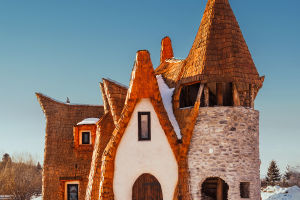The Netherlands is often referred to as the "Land of Windmills," and it's a country of just over 10 million people in Western Europe. The primary purpose of windmills is to convert wind energy into a beneficial form, such as electricity.
Wind is simply the kinetic energy of air movement. The more the air is stirred up, the more energy is generated. Large wind farms consist of hundreds of individual wind turbines that are connected to a power transmission network.
Compared to conventional energy sources, wind power has a lower environmental impact because it causes less pollution. Unlike fossil fuel energy sources, wind power does not consume fuel and emits no air pollution. Let's explore some of the world's most famous and ancient windmills that exist on this planet.
1. Rhodes Windmill
The Mandraki windmills are located in Mandraki Harbor, Rhodes Island. These medieval windmills helped crush grain transported through merchant ships that docked in the harbor.
According to legend, there were 13 or 14 windmills long ago, but almost all of them were demolished over time. Three of these magnificent structures have been restored to their former glory. Today, Mandraki is an important tourist destination with many waterfront cafes where visitors can see yachts and fishing boats.
2. Oran Windmills
The windmills dominate the landscape of Oran. In the mid-19th century, Oran boasted about 2,000 windmills, and by the turn of the century, that number was virtually unchanged. As animal husbandry became more common, it was almost essential that every self-respecting farm had its own windmill.
However, by the beginning of the 20th century, the windmills began to fall into disrepair. Old farms were renovated with new technology, and highly efficient commercial mills were introduced. A famous example of a windmill on Oran is the row of mills in Lekaka, considered by many to be the most beautiful and well-preserved on Oran.
3. Sans Anse Windmills
Located north of Amsterdam is the Sans Anse windmill, which displays a well-preserved glimpse of Dutch history. It is a mix of traditional houses, windmills, workshops, and warehouses. The area was of great industrial importance in the 18th and 19th centuries, as hundreds of windmills were used here to produce linseed oil, paint, snuff, mustard, paper, and other products.
Many of the unique village homes in the Sans Anse Windmills village have been turned into museums, gift stores, or workshops. Some apartments are still private residences. The remains of the Sans Anse windmill are open to the public, and millions of visitors come each year to enjoy its beauty. It is considered one of the most popular attractions in the Netherlands.
4. Mykonos Windmill
Windmills are popular among tourists and are a great example of the Greek island of Mykonos. Windmills can be seen in every part of the main village of Mykonos, known as Chora. They are visible when sailing towards the port of Alexandria, as they are located on the cliffs in the area. Almost all of the windmills face north, where the wind is strongest most of the year.
Mykonos currently has 16 windmills, 16 of which are located on a prominent hill in Chora. The Venetians built many windmills in the 20th century, but construction continued until the beginning of the 21st century. These windmills were mainly used for grinding wheat and were therefore one of the most important sources of income for the inhabitants. Their use diminished as technology advanced.


